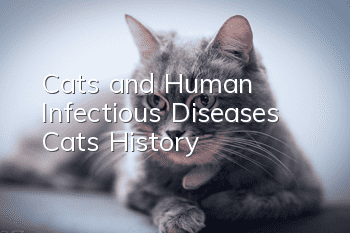Cats and Human Infectious Diseases: Cats’ History

The latest cover of the magazine "Emerg Infect Dis." published by the US CDC published a painting: "two lucky cats to support leadership”. The role of cats in the history of human infectious diseases is described for us.
Cats were the first in history to control diseases transmitted from rodents to humans. But cats can also transmit a variety of zoonotic diseases, including Campylobacter infection, cat scratch disease (also known as cat scratch fever), cryptosporidiosis, plague, rabies and salmonellosis. It reminds us that we need to pay more attention to hygiene during the process of "petting cats" to avoid the spread of viruses from cats to humans and cause cross-infection. The title of the article is: In Consideration of Our Mutual Relationship with Cats.
History of Domestication of Cats
Domestic cats (Cat, Felis catus) are members of the family (Family) The only domesticated species in the family Felidae that breeds on all continents except Antarctica. It thrives in almost any climate and environment and is one of the most invasive species in the world. Current estimates of the global cat population range from 200 million to 600 million individuals. Wherever there are humans, there are most likely cats.
According to research, humans living in agricultural villages in northern Africa and the Near East domesticated the African wild cat (Felis lybica) 8,000 to 12,000 years ago. Archaeologist Magdalena "How cats are domesticated is a complex and unresolved topic," Krajcarz and colleagues note. It may be that the grain and garbage piles stored in the village attracted rodent pests (such as rats, etc.), which in turn attracted local feral cats. This reciprocal relationship fosters harmony between humans and cats. WriterLee Harper and Joyce L. White have also written that ancient sailors discovered that cats on ships protected their food supplies from rodents.
In medieval Europe, some religious institutions believed that cats were evil, leading to the slaughter of thousands of cats. However, the Black Death, later spread by fleas on rats, helped to redeem the cat.
Feline coronavirus
According to statistics, viral infectious diseases in cats include single-stranded DNA parvovirus, namely feline distemper; calicivirus; herpes The virus is feline nasal congestion; coronavirus is feline infectious peritonitis. Among them, feline coronaviruses (FCoVs) are enveloped RNA viruses, including feline infectious peritonitis virus (FIPV) and feline enteric coronavirus (FECV)..
Feline enteric coronavirus is highly contagious, mainly through feces and digestive tract. However, in real life, due to the lack of specific symptoms in sick cats and the low sensitivity of commonly used detection methods, it is very difficult to diagnose and confirm the diagnosis. At present, the diagnosis of abdominal transmission in cats is generally based on historical diseases, blood tests, tissue sections, etc. If a sick cat develops a fever and antibiotic treatment has no obvious effect, you can basically suspect Feline Infectious Peritonitis (FIP).
Most sick kittens are between 6-8 weeks old. At this time, maternal antibodies gradually disappear and their own immunity has not yet been fully established (this is why cat dealers like to sell two Kittens under 6 months old are less likely to get sick because they have maternal antibodies).
Cats and Human Diseases
Cats are the only animals in which Toxoplasma gondii can complete its life cycle. People who come into close contact with cat litter are at risk of contracting toxoplasmosis, and pregnant women may also transmit toxoplasmosis to their fetuses. Even less common is the transmission of disease from humans to animals, such as the suspected case of severe acute respiratory syndrome coronavirus 2 transmission from humans to cats.
Although "cat petting" can provide emotional support, improve mood, and help improve the owner's overall appearance and promote the socialization of the elderly or intellectually disabled people. But living with cats also comes with some health risks. Cats can transmit a variety of zoonotic diseases, including Campylobacter infection, cat-scratch disease (also known as cat-scratch fever), cryptosporidiosis, hookworm infection, plague, rabies, and salmonellosis (although some Belongs to an intermediate host or only plays the role of "intermediate transmitter").
Fungal infections are the most common in cats. In ringworm, the skin itches and the lesions appear ring-shaped, which may cause hair loss. It can be transmitted by direct contact, contact with cat saliva, cat feces or other body fluids, or through contact with water, food, bowls, and bedding used by infected cats.
Prevention:
1. Wear gloves when handling cat feces.
2. Through training, calm the cat’s emotions and avoid attacks that may cause scratches, bites, etc.
3. Wash your hands frequently, do not rub your eyes, etc.
4. Feed correctly, pay attention to hygiene, deworm and immunize regularly.
5. Avoid raw food and raw meat. Complete cat food.
- What should I do if two cats keep fighting?
- How long does it take for a cat to grow hair after shaving?
- Why do cats hate bathing? Are all cats afraid of water?
- What are the symptoms of Siamese cat pregnancy?
- Main causes of vomiting in cats
- What should I do if my Persian cat suffers from heatstroke? The most important thing for the poop shoveler in summer!
- Master these tips to help your cat remember his name!
- Will cats die if they get rhinitis? How to deal with rhinitis?
- How to properly care for your cat’s teeth?
- What should an owner do when a cat steps on the milk?



